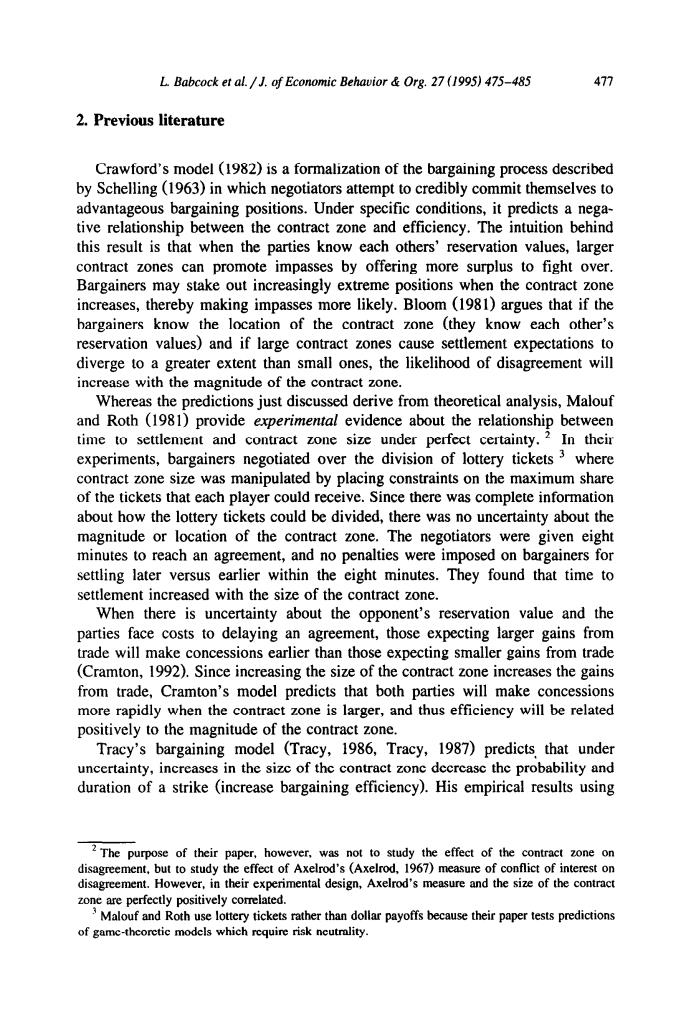正在加载图片...

L Babcock et al /J.of Economic Behavior Org.27(1995)475-485 477 2.Previous literature Crawford's model (1982)is a formalization of the bargaining process described by Schelling(1963)in which negotiators attempt to credibly commit themselves to advanta s ha argaining po sitions.Under spe ific it predicts tive relationship between the contract zone and efficiency.The intuition behind this result is that when the parties know each others'reservation values,larger contract zones can promote impasses by offering more surplus to fight over. Bargainers may stake out increasingly extreme positions when the contract zone increa ses,thereby r making mpasses nore likely.Bloom(1981)argues that if the hargainers know tion of the e contract zone (the ey know each other's reservation values)and if large contract zones cause settlement expectations to diverge to a greater extent than small ones,the likelihood of disagreement will increase with the magnitude of the contract zone. eras the prdctions just discuedvmis.Malour and Roth (191)provide experimental evidence abou hip betw time to settlement and contract zone size u nder perfect certainty. In thei experiments,bargainers negotiated over the division of lottery tickets3 where contract zone size was manipulated by placing constraints on the maximum share of the tickets that each player could receive.Since there was complete information about how the lottery ticke s could be divided,there was no uncertainty about the magnitud e or ocation of the contract zone The negotiators were given eight minutes to reach an agreement,and no penalties were imposed on bargainers for settling later versus earlier within the eight minutes.They found that time to settlement increased with the size of the contract zone When there is uncertainty about the nent'e reservation value and the parties ace costs to delaying an agreement,those expecting larger gains from trade will make concessions earlier than those expecting smaller gains from trade (Cramton,1992).Since increasing the size of the contract zone increases the gains from trade.Cramton's model predicts that both parties will make concessions pidly wher the contract zone is larger and thus efficiency will be related pos itivelyt the magnitude of the contrac Tracy's bargaining model (Tracy,1986,Tracy,1987)predicts that unde uncertainty,increases in the sizc of the contract zonc decrcasc the probability and duration of a strike (increase bargaining efficiency).His empirical results using of thei the effect of the disa disagmnt.However,in theirxrmental design,Axed's measure and the size of the coract and R s ra lar payoffs because their paper tests prediction f L. Babcock et al. / J. of Economic Behavior & Org. 27 (1995) 475-485 411 2. Previous literature Crawford’s model (1982) is a formalization of the bargaining process described by Schelling (1963) in which negotiators attempt to credibly commit themselves to advantageous bargaining positions. Under specific conditions, it predicts a negative relationship between the contract zone and efficiency. The intuition behind this result is that when the parties know each others’ reservation values, larger contract zones can promote impasses by offering more surplus to fight over. Bargainers may stake out increasingly extreme positions when the contract zone increases, thereby making impasses more likely. Bloom (1981) argues that if the bargainers know the location of the contract zone (they know each other’s reservation values) and if large contract zones cause settlement expectations to diverge to a greater extent than small ones, the likelihood of disagreement will increase with the magnitude of the contract zone. Whereas the predictions just discussed derive from theoretical analysis, Malouf and Roth (1981) provide experimental evidence about the relationship between time to settlement and contract zone size under perfect certainty. * In their experiments, bargainers negotiated over the division of lottery tickets 3 where contract zone size was manipulated by placing constraints on the maximum share of the tickets that each player could receive. Since there was complete information about how the lottery tickets could be divided, there was no uncertainty about the magnitude or location of the contract zone. The negotiators were given eight minutes to reach an agreement, and no penalties were imposed on bargainers for settling later versus earlier within the eight minutes. They found that time to settlement increased with the size of the contract zone. When there is uncertainty about the opponent’s reservation value and the parties face costs to delaying an agreement, those expecting larger gains from trade will make concessions earlier than those expecting smaller gains from trade (Cramton, 1992). Since increasing the size of the contract zone increases the gains from trade, Cramton’s model predicts that both parties will make concessions more rapidly when the contract zone is larger, and thus efficiency will be related positively to the magnitude of the contract zone. Tracy’s bargaining model (Tracy, 1986, Tracy, 1987) predicts. that under uncertainty, increases in the size of the contract zone decrease the probability and duration of a strike (increase bargaining efficiency). His empirical results using *The purpose of their paper, however, was not to study the effect of the contract zone on disagreement, but to study the effect of Axelrod’s (Axelrod, 1967) measure of conflict of interest on disagreement. However, in their experimental design, Axelrod’s measure and the size of the contract zone are perfectly positively correlated. 3 Malouf and Roth use lottery tickets rather than dollar payoffs because their paper tests predictions of game-theoretic models which requite risk neutrality